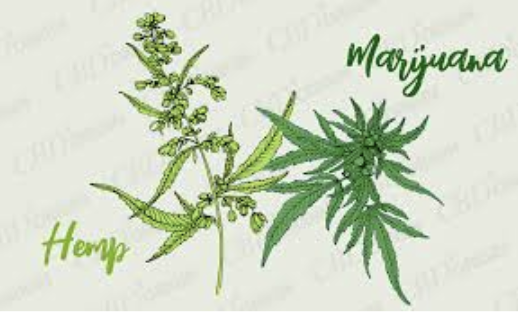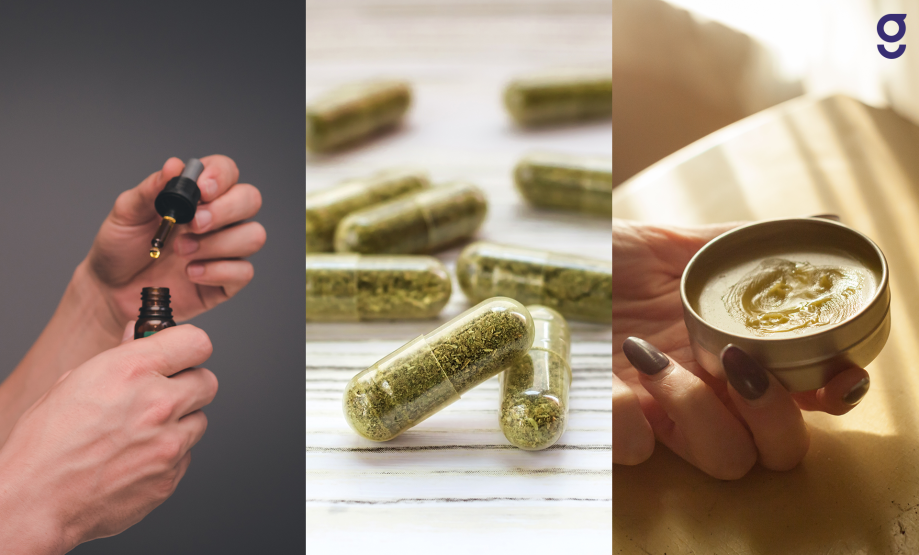CBD: Benefits, Types, & Side Effects
CBD, or cannabidiol, is recommended for everything from anxiety and stress to indigestion and depression. And, a lot of people are using it. A recent Gallup poll found 1 in 7 adults in the U.S. has used CBD.
So, does it help? Studies of CBD are ongoing, but some benefits have been found.
What is CBD?
CBD is an herbal remedy – a treatment that comes from a plant, in this case, it is the cannabis sativa plant. Cannabis sativa has been used for thousands of years for both its healing and mind-altering effects.
There are two types of cannabis sativa: hemp and marijuana. The hemp plant is the source of CBD used in most products.

Hemp and marijuana plants
CBD Defined
CBD is one of a group of substances called cannabinoids derived from the cannabis sativa plant.
There are dozens of cannabinoids, as well as other substances, in cannabis sativa.
CBD is the primary cannabinoid in hemp. It has various healing properties. For example, it seems to lessen inflammation, the body’s response to illness or injury. In this way, it may help treat many different diseases.
CBD is not psychoactive; it does not have a mind-altering effect.
CBD vs. THC
To better understand CBD, it helps to contrast it with tetrahydrocannabinol (THC). Many people are familiar with THC. It is the best known of the cannabinoids. THC was identified long before CBD. THC is the substance in marijuana that causes the high.
Marijuana contains more THC than CBD. Hemp has a very small amount of THC, less than 0.3 percent, and not enough to cause a high. As of 2018, CBD from hemp became legal in the U.S. with the Food and Drug Administration (FDA) maintaining control.
CBD’s main property is healing and it’s derived from the hemp plant. On the other hand, THC’s main property is mind-altering and it’s derived from the marijuana plant.
Excessive and continued use of CBD may lead to side effects, including memory loss, slow reaction time, and changes in mood such as irritability.
How CBD Works
The way CBD works -- and the systems it affects in the body -- is complicated and still under study.
As stated above, CBD is in a class of chemicals called cannabinoids. Because it comes from a plant, it is further classified as a phytocannabinoid.
The human body also produces natural cannabinoids, called endocannabinoids.
Both variations of cannabinoids act on cannabinoid receptors. These receptors are part of the complex endocannabinoid system (ECS). The system regulates the release of neurotransmitters (chemicals that communicate between nerve cells) in the brain, as well as in other parts of the nervous system. The ECS responds to both types of cannabinoids, phyto- and endo-.
By acting on the ECS, CBD may have many different effects on the body. Examples include: balancing the body’s overall physical functions (homeostasis), reducing pain sensation, and lessening the body’s reaction to injury or inflammation.
Medical Uses of CBD
CBD has been recommended for many different purposes, some of them tested, and some not. The prescription drug Epidiolex is the only CBD product approved by the FDA. It may be prescribed to treat two rare seizure disorders, or types of epilepsy, in children and adults.
Studies are ongoing, but some results show that CBD may be effective in reducing anxiety/stress and chronic (long-term) pain like back pain. It may also be effective for insomnia, or trouble sleeping.
There are studies of oral, topical, and inhaled CBD products for use in many other conditions, including dystonia (movement disorder), Fragile X syndrome (rare genetic disorder), graft-versus-host disease (bone marrow transplant rejection), multiple sclerosis (MS), opioid withdrawal, schizophrenia, and smoking cessation. CBD is also used to alleviate symptoms associated with Parkinson’s disease, but some study results advise against it.
Types of CBD Products
CBD products can be used by mouth (oral/edible) or applied to the skin (topical). These products have different concentrations of CBD.
CBD oil may be used both ways.
Other oral products include edible gummies and capsules. Topical CBD products may also be found in lotions, creams, or balms. Again, they are available in various concentrations.
CBD Dosage
The proper dosing of CBD for different conditions is still being studied, so new information is continuing to become available.
CBD should be used according to the manufacturer’s instructions. Make sure you read and follow the label carefully. Only use the amount instructed. Using more may increase the chance of side effects, interactions, or other problems.
The dose of a CBD product depends on the form and strength, as well as the concentration of CBD in it. It’s also based on whether or not it has other active ingredients.
Side Effects and Interactions of CBD
Early studies show that most people tolerate CBD products well, however, side effects can occur.
Common CBD side effects include: drowsiness, dry mouth, vomiting, decreased appetite, weight loss, and abnormal liver function blood tests.
INTERACTIONS: Check with your doctor or pharmacist before taking CBD with other medications. CBD may interact with some commonly prescribed medications including warfarin, lithium, sertraline, tramadol, codeine, captopril, and valproic acid and carbamazepine (both are anti-seizure medications).Fatty foods may increase the absorption of CBD.
CAUTIONS: People with liver problems or Parkinson’s disease should not take CBD.
Do not use CBD with medicines that are prescribed to control seizures or epilepsy (e.g. valproic acid or carbamazepine).
CBD may increase drowsiness when taken with other sedating medicines or herbal products.
Medical Research
Oral CBD for Pain
Research on the safety and effectiveness of oral CBD for pain is ongoing. Some of the research includes:
The National Academies of Sciences (NAS) found significant evidence that cannabis was an effective treatment for long-term (chronic) pain. However, much of the research was done outside of the U.S. And the forms of cannabis studied in the U.S. were not the same as those commonly used.
Reviews and meta-analyses of cannabinoids found the following:
Studies looked at the use of cannabinoids (THC alone and CBD combined with THC) in people with chronic pain. In general, results showed improvements in pain measures, but they were not statistically significant.
Studies found evidence, although not high-quality, that cannabis-based medicines reduced long-term nerve (chronic neuropathic) pain. All but two studies used plant-based THC/CBD mouth spray products (the other two used synthetic oral THC products).
Results of observational studies and randomized controlled trials (RCTs) of the effectiveness of cannabinoids in chronic non-cancer pain showed a 30% reduction in pain in 1 out of 3 of those using cannabinoids. These results were considered significant.
Topical CBD for Pain
There is also continuing research on the safety and effectiveness of topical CBD. Some of the research includes the following:
Although not in humans, an animal study found transdermal CBD had the ability to lessen the pain and inflammation of arthritis.
Topical cannabidiol oil was studied in 29 people with lower limb peripheral neuropathy. After using the oil for 4 weeks, results showed less intense and sharp pain and fewer other uncomfortable sensations.
Applications of transdermal cannabidiol were studied in people with temporomandibular (joint of the jaw) disorders (TMD) that caused myofascial (coverings of muscle) pain. Those studied had less muscle tension and pain after applying the topical CBD for 2 weeks.
Oral CBD to Help with Sleep
Oral CBD products may be used to help with sleep. This research includes the following:
Early results of research suggest that a 160mg dose of cannabidiol before bed significantly improves sleep duration compared to a placebo in patients with insomnia. Smaller doses did not have this effect. Also, patients did not feel drowsy the next morning.
Early research on CBD for the treatment of insomnia suggests that it may be effective. Additional studies are needed.
Animal studies of CBD found increased total sleep and improved sleep quality when sleep issues were associated with anxiety/stress.
Medical cannabis users reported they used cannabis with higher CBD and lower THC concentrations for their insomnia. They also reported a decrease in the time required to fall asleep.
A review and meta-analysis of 8 studies with low-quality evidence of cannabis-based medicines found that they were better at reducing sleep problems compared to inactive medicines (placebo).
A review of clinical trials of the effect of cannabinoids on sleep suggested that cannabinoids could improve sleep quality, decrease sleep disturbances, and decrease the time it takes to fall asleep. However, there were limiting factors, such as the small size of the studies.
An app was used to measure changes in insomnia in over 400 people taking medical cannabis. Results showed an average symptom severity reduction of 4.5 points on a 10-point scale, a significant improvement in insomnia.
Another review with meta-analysis of 104 studies evaluated cannabinoids for the treatment of chronic non-cancer pain. Within this review and analysis, the effect of cannabinoids on sleep was also examined. There was low-quality evidence of improved sleep.
Conclusion
The takeaway is that the initial research of CBD is promising but there is still much to learn. It may help with some conditions like long-term pain and sleep.
Because it is so widely available and recommended for so many problems, it must be used carefully and purchased from reliable sources.
CBD is just one of many supplements that can alleviate back pain or insomnia. Take a Goodpath assessment for an integrative program that incorporates supplements, nutrition, mind-body therapies, and exercise.
